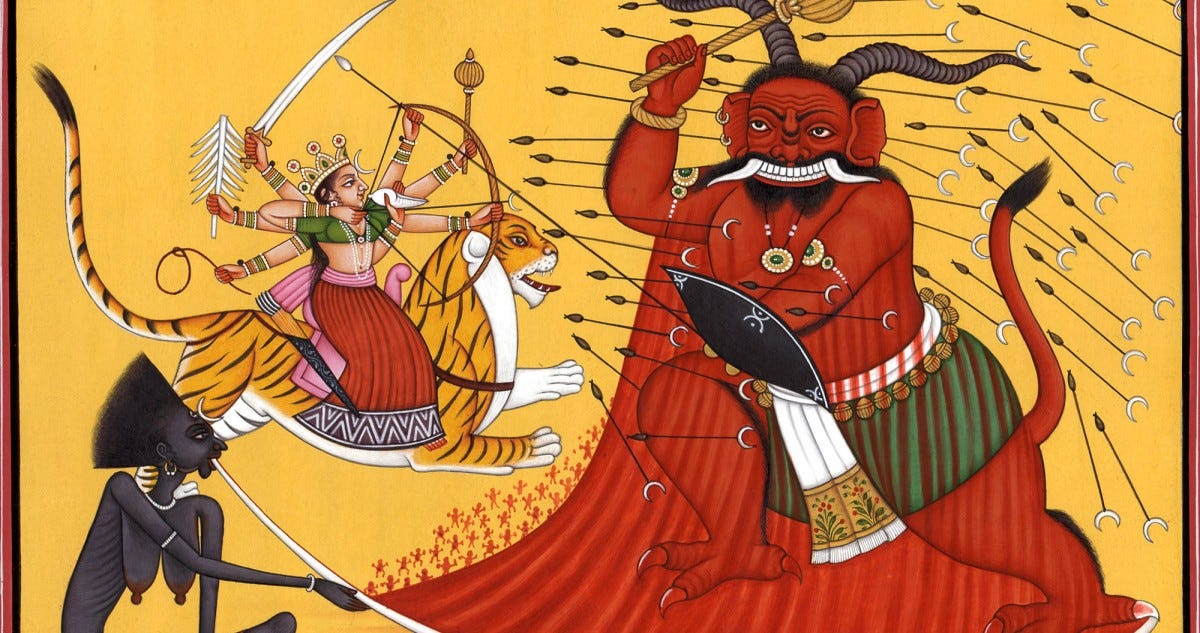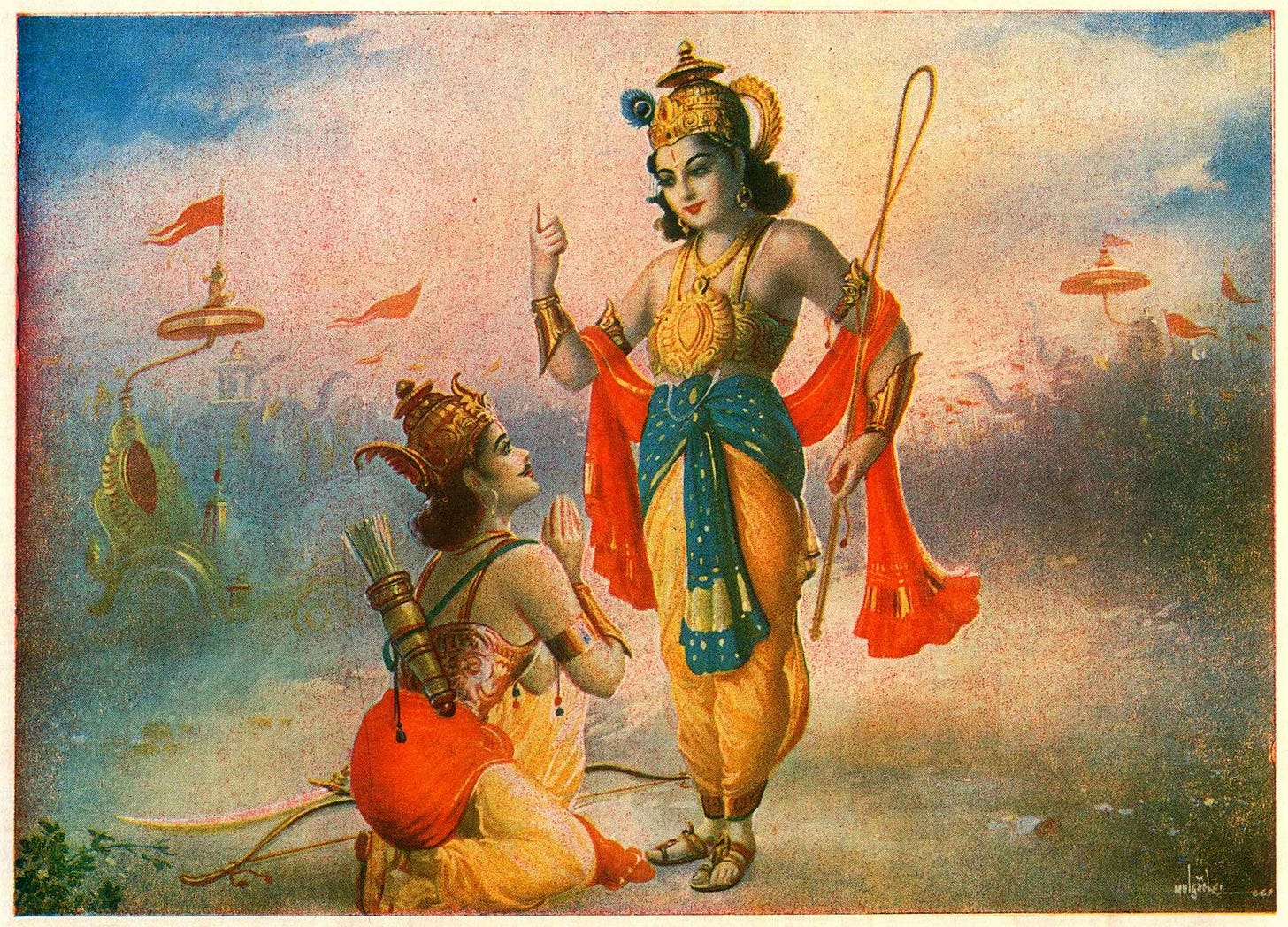Escape from Samsara: Part 3, The Kali Yuga
Brahman is not to be found in temples or mountaintops, priests or mumbo jumbo. Rather the seat of God resides within you as you
6). The Bhagavad Gita
In the post-Vedic epic, The Mahabharata, the death of Krishna following the Kurukshetra War marks the beginning of the cosmic age, the Kali Yuga.
Believed to be the present era, the Kali Yuga is the fourth and most sinful of the world ages, marred by conflict, destruction, deceit, hypocrisy, sleepiness, bewilderment, fear, and poverty. It is a world of widespread famine, excess taxes, and mass immigration. A world without religion, ruled by corrupt politicians, where wealth and status alone are the measure of virtue.
Against this impending storm Krishna’s conversation with his cousin, the fearless warrior Arjuna enshrined in the 700-verse jewel of The Mahabharata, The Bhagavad Gita, contains perhaps the most important teaching from ancient India:
‘The immortal soul is more important than the passing world.’
The mischievous cowherd, Krishna comes to the world as the eighth Avatar of Vishnu, to end a Yuga by sowing the seed that will sprout into a brutal war – a war to end all wars, a war that will remove the burden of evil from the world and restore Dharma upon the crack of the ages.
It is Krishna’s gift to Arjuna to remind him to stand by his own Dharma even if it means going against his own family, because ‘where there’s Dharma there’s victory’.
Dharma is the law that expresses and maintains the unity of creation. It speaks to the moral duties that govern conduct and provides a glimpse into the kind of world we want to see rising from the ashes of the Kali Yuga. We do unto others as we would have done unto ourselves, for every event is both a cause and effect (karma), you cannot have one without the other when every action unleashes a ripple on the cosmic sea that vibrates throughout the eons of time.
The Gita reminds us to bring awareness into our lives, through the daily spiritual practice (Sadhana) in order to transform even the most mundane tasks into acts of spiritual devotion and so that we may find our way back home to the place where the transient data of the world cohere into the unified order (Brahman); once we attain the highest understanding of our true self, the conscious knower of all beings - all beings in the self and the self in all beings - (Atman).
But the final goal of life is to free ourselves from endless cycles of suffering (Samsara), achieved with the awakening of the self (Moksha), from the dream where nothing seems real except the dream (Maya).
There are many great barriers to mass spiritual awakening. FBI founding director, J Edgar Hoover called upon the function of mass agitation:
“to exploit all the grievances, hopes, aspirations, prejudices, fears, and ideals of all the special groups that make up our society, social, religious, economic, racial, political. Stir them up. Set one against the other. Divide and conquer. That’s the way to soften up a democracy.”
If anything epitomises the false robes of progression that shroud today's era in a fog of ignorance, it’s these prophetic words as race, gender and left-right polarisation pits one segment of society against another, satanic death cults blow the sea conch of world war and minorities who were once oppressed by the system are unleashed as its oppressors.
As an elixir to these dark times, the light of Vedic philosophy shines through the cracks of a scorched earth and illuminates a path to liberation by showing us that every point of creation, no matter how arbitrary, contains the whole of creation and that we can access every vector of life by accessing our true selves.
Ordinary people and not billionaire elites are the flesh and blood of the cosmos, and the shadows flickering on the cave wall holding us captive, do not spring from the bulwarks of a tyrannical government but from inside our own mind-forged manacles. It is on account of the costumes we wear, scripts we read and characters we portray, that the unyielding truth has been transformed into temporal illusion.
Once you understand this you have the power to awaken in harmony with an awakened cosmos. It becomes more than a moral duty, it becomes a pleasure to raze their house of cards to the ground and destroy anything for that matter, which disturbs or renounces the unified order we belong to.
But tread carefully. The mind's interaction with the phenomenal world creates duality, delusion and suffering. It is through the pursuit of truth that we flounder into ignorance, since the pursuit of anything purely for the fruits of its rewards leads to more attachment, egoism, worldliness, karma, and Samsara.
It is said that the beginner's mind is more equipped for daily spiritual practice, Sadhana, than an intellectual mind full of theories and concepts.
Brahman is not an object of truth nor something to gain or possess, rather it is our spiritual goal to achieve liberation from everything, particularly ourselves and that illusive ideal, the truth. The highest pursuit of anything is to transcend it by entering a state of pure awareness where there’s no distinction between the experience and the experiencer and all that remains is pure knowing without the duality of knowledge as the reward. In this state of enlightenment, the Brahman mind enters pure awareness and regards all pairs of opposites - whether heat or cold, pleasure or pain – the same, and is therefore undisturbed by either imposter, success or failure.
Brahman is not to be found in temples or mountaintops, priests or mumbo jumbo. Rather the seat of God resides within you as you and becomes self-evident once the mind is restrained and senses withdrawn, at which point we emerge from the darkened cave free of illusions as the pure witness. The object changes from one moment to the next, but the essence of the subject - pure observation, remains the same.
The Mahabharata teaches us that ‘nothing can be done with what is written in the stars… since there are deeper designs in the world than we can fathom…and fate tests those whom she would exalt.’ The Kali Yuga is inescapable. The New World Order have made their move. It is said that all great empires come to an end. We face our greatest historical battle - one we may never win in any conventional sense of what it means to be victorious. But that doesn't matter, the Gita reminds us that the immortal soul never dies, for it is never born, it is eternal.



I enjoyed your article very much.
I hope it is OK, I have some thoughts relating to this topic.
I am asking what is the division between within and without after all? We impact the field and change the world around us by the frequency of our thoughts and it is well said that the world is a mirror to ourself.
So is there really a battle? What is the drama except the depth of the illusion driving this apparent separation? It is another form of self discovery that has only one resolution. As you may say Brahman discovering itself. All is just that after all.
However this implies evolution, self discovery, growth and consider that we may be here now on this density because we have been self destructive, that we have denied our divinity in ourselves, and that we are in process of returning to source.
So there is a problem if there is a degree of stuckness on the part of humanity, as elucidated by such as
The Politics of Obedience: The Discourse of Voluntary. Servitude by Étienne de la Boétie, written 1552-53.
Showing that it is just complacency that allows the elite to rule in tyranny of the masses.
https://cdn.mises.org/Politics%20of%20Obedience.pdf
then surely we can ask if the crisis we face is the shock we have to have to shift us out of this natural complacency and into a more integrated society in tune with the unified order we belong to. ?
Surely we only need to awaken to our true selves.? But if we are stuck in a complacent somnambulance then we have come up against our own shadow, and it is a crisis of our own making that we need to face? To cease denying the divinity with us?
As you say –
“As an elixir to these dark times, the light of Vedic philosophy shines through the cracks of a scorched earth and illuminates a path to liberation by showing us that every point of creation, no matter how arbitrary, contains the whole of creation and that we can access every vector of life by accessing our true selves. “
Moving forward we could well imagine a world that is in harmony with the universal truth “We do unto others as we would have done unto ourselves:”
living and being in sympathy with this truth implies integration with all.
This is the world we can awaken to if we connect with our higher self and vibrate with the frequency of love.
It is who we truly are.
I may need to re-read this third part, which didn't quite resonate with me in the same way that the earlier two articles did. But an awesome essay nonetheless, and the points where I'd quibble are simply because of having more familiarity with (Theravadan) Buddhist understanding of samsara, and how the wheel is kept spinning round.
The process was explained by Gautama in the Paṭiccasamuppāda Sutta and known familiarly as the theory of dependent origination. One rendition of the Sutta is this one: https://suttacentral.net/sn12.1/en/bodhi
A supreme irony, a couple of years ago, was to 'attend' via Zoom a teaching by Bhikkhu Bodhi - the scholar who has translated great swathes of the Pali Canon (including the link above). He was very evidently, as a typical New Yorker I guess, wholly sold on the notion that the Cronyvirus was deadly and that the only hope was to follow the advice of the esteemed Dr Fauci, who he named specifically and with warmth. Many other religious leaders (and academics) blundered down this same path.
Anyway: the process of dependent origination is illustrated in the outer ring of the bhavacakka illustration shown at the top of part 1. The fearsome creature that holds the wheel is Mara, death. (Maya, by the way, was the name of Gautama's mother, apparently.)
But the essential principle, as you've captured so very well in Pt. 1, is the 'looping' character of our self-delusions, and how these are set spinning or gather added momentum due to malicious narratives and deployment of power (as outlined in Pt. 2).
How do some people resist this more succesfully than others, I wonder? There's a whole other essay there..!